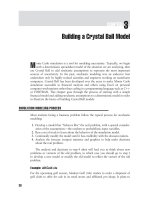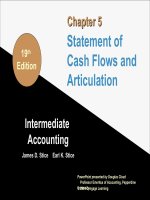Managerial decision modeling with spreadsheets by stair render chapter 05
Bạn đang xem bản rút gọn của tài liệu. Xem và tải ngay bản đầy đủ của tài liệu tại đây (1.09 MB, 40 trang )
Chapter 5:
Transportation, Assignment
and Network Models
© 2007 Pearson Education
Network Flow Models
Consist of a network that can be represented with nodes and arcs
1. Transportation Model
2. Transshipment Model
3. Assignment Model
4. Maximal Flow Model
5. Shortest Path Model
6. Minimal Spanning Tree Model
Characteristics of Network Models
•
•
•
A node is a specific location
An arc connects 2 nodes
Arcs can be 1-way or 2-way
•
•
•
Types of Nodes
Origin nodes
Destination nodes
Transshipment nodes
Decision Variables
XAB = amount of flow (or shipment) from
node A to node B
Flow Balance at Each Node
(total inflow) – (total outflow) = Net flow
Node Type
Origin
Destination
Transshipment
Net Flow
<0
>0
=0
The Transportation Model
Decision: How much to ship from each
destination?
Objective: Minimize shipping cost
origin to each
Data
Decision Variables
Xij = number of desks shipped from factory i
to warehouse j
Objective Function: (in $ of transportation cost)
Min 5XDA + 4XDB + 3XDC + 8XEA + 4XEB +
3XEC + 9XFA + 7XFB + 5XFC
Subject to the constraints:
Flow Balance For Each Supply Node
(inflow) - (outflow) = Net flow
- (XDA + XDB + XDC) = -100
(Des Moines)
OR
XDA + XDB + XDC = 100
(Des Moines)
Other Supply Nodes
XEA + XEB + XEC = 300
(Evansville)
XFA + XFB + XFC = 300
(Fort Lauderdale)
Flow Balance For Each Demand Node
XDA + XEA + XFA = 300
(Albuquerque)
XDB + XEB + XFB = 200
(Boston)
XDC + XEC + XFC = 200
(Cleveland)
Go to File 5-1.xls
Unbalanced Transportation Model
•
If (Total Supply) > (Total Demand), then for each supply node:
(outflow) < (supply)
•
If (Total Supply) < (Total Demand), then for each demand node:
(inflow) < (demand)
Transportation Models With
Max-Min and Min-Max Objectives
•
Max-Min means maximize the smallest decision variable
•
Min-Max mean to minimize the largest decision variable
•
Both reduce the variability among the Xij values
Go to File 5-3.xls
The Transshipment Model
•
•
Similar to a transportation model
Have “Transshipment” nodes with both inflow and outflow
Node Type
Supply
Demand
Transshipment
Flow Balance
inflow < outflow
inflow > outflow
inflow = outflow
Net Flow
(RHS)
Negative
Positive
Zero
Revised Transportation Cost Data
Note: Evansville is both an origin and a
destination
Objective Function: (in $ of transportation cost)
Min 5XDA + 4XDB + 3XDC + 2XDE + 3XEA + 2XEB + 1XEC + 9XFA + 7XFB + 5XFC + 2XFE
Subject to the constraints:
Supply Nodes (with outflow only)
- (XDA + XDB + XDC + XDE) = -100 (Des Moines)
- (XFA + XFB + XFC + XFE) = -300 (Ft Lauderdale)
Evansville (a supply node with inflow)
(XDE + XFE) – (XEA + XEB + XEC) = -300
Demand Nodes
XDA + XEA + XFA = 300
(Albuquerque)
XDB + XEB + XFB = 200
(Boston)
XDC + XEC + XFC = 200
(Cleveland)
Go to File 5-4.xls
Assignment Model
•
•
For making one-to-one assignments
Such as:
– People to tasks
– Classes to classrooms
– Etc.
Fit-it Shop Assignment Example
Have 3 workers and 3 repair projects
Decision: Which worker to assign to which
project?
Objective: Minimize cost in wages to get all
3 projects done
Estimated Wages Cost
of Possible Assignments
Can be Represented
as a Network Model
The “flow” on each arc is either 0 or 1
Decision Variables
Xij = 1 if worker i is assigned to project j
0 otherwise
Objective Function
(in $ of wage cost)
Min 11XA1 + 14XA2 + 6XA3 + 8XB1 + 10XB2 +
11XB3 + 9XC1 + 12XC2 + 7XC3
Subject to the constraints:
(see next slide)
One Project Per Worker (supply nodes)
- (XA1 + XA2 + XA3) = -1
(Adams)
- (XB1 + XB2 + XB3) = -1
(Brown)
- (XC1 + XC2 + XC3) = -1
(Cooper)
One Worker Per Project (demand nodes)
XA1 + XB1 + XC1 = 1
(project 1)
XA2 + XB2 + XC2 = 1
(project 2)
XA3 + XB3 + XC3 = 1
(project 3)
Go to File 5-5.xls
The Maximal-Flow Model
Where networks have arcs with limited capacity, such as roads or pipelines
Decision: How much flow on each arc?
Objective: Maximize flow through the network from an origin to a destination
Road Network Example
Need 2 arcs for 2-way streets
Modified Road Network
Decision Variables
Xij = number of cars per hour flowing from
node i to node j
Dummy Arc
The X61 arc was created as a “dummy” arc to measure the total flow from node 1 to node 6









